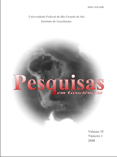Sedimentação de Longo e Curto Período na Lagoa dos Patos, Sul do Brasil
DOI:
https://doi.org/10.22456/1807-9806.19516Palavras-chave:
Lagoa dos Patos, sedimentation rate, environmental impacts.Resumo
Lagoa dos Patos in southern Brazil is part of the largest lagoonal system in South America. The Holocene lagoonal sediments of the Lagoa dos Patos, mostly muds, have an average thickness of about 6 m as determined by 297 km of 7.0 kHz echograms. Holocene muddy sedimentation developed over a probable Upper Pleistocene coastal plain, whose surface has a subbottom reflector that could not be penetrated by the energy of a 7.0 kHz seismic wave. The characteristics of this reflecting surface suggest indurated Pleistocene muds and/or sediments that are coarser than the overlying muddy deposits of Holocene lagoon. Based on stratigraphic correlation and the local sea level curve, we estimate that Holocene sedimentation started about 8.0 ka ago. This yields an average deposition rate of 0.75 mm/yr. A broadly comparable average rate of 0.52 ± mm/yr was obtained for cored intervals between 14C samples from the upper part of these muddy Holocene lagoon deposits. These long-term sedimentation rates are much slower than rates based on two determinations of 210Pb for surface muds deposits in the last 150 years, which yielded values of 3.5 and 8.3 mm/yr. Quite possibly the high short-term rates may be the result of more rapid lagoonal sedimentation related to deforestation of the watershed of the lagoon and other impact types related with human activities during the 150 years of European colonization in the Rio Grande do Sul state. Also, the aim of this study is to identify present and possible future environmental problems related with high lagoonal sedimentation rates such as the water quality, port dredge and the presence of mud deposits on the oceanic beach.



